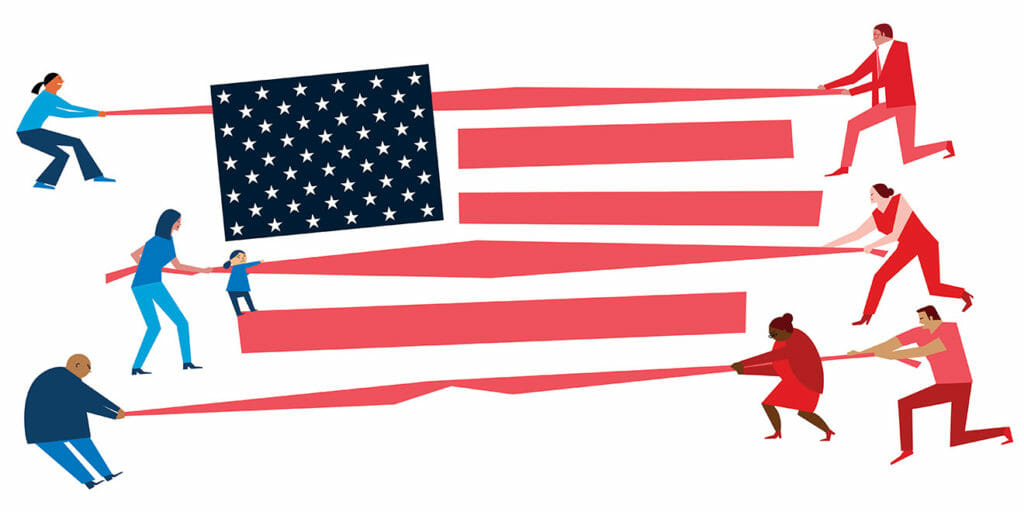These days, when you see a brand trending on Twitter, it can only mean one thing: they got political.
Brands aligning themselves with a cause is no new thing, but there’s something about the social media age that makes it electric. Even a low-risk cause, like suggesting that men should aim to be the best versions of themselves, is enough to start hashtag boycotts and video challenges of people destroying their own property. For better or worse, we’re in an era where if people don’t like a particular cause you’ve supported, they will actively search and destroy your ad partnerships. The modern relationship between brands and politics is super interesting, and has led me to the following three questions.
1. Why do people respond so emotionally to brands?
2. Can brands stand for more than profit?
3. If you’re going to get political, how do you do it in a way that feels authentic?
Millennial Marketing and Brand Democracy
As an agency that specializes in emotion, it’s been fascinating to watch the increasingly volatile connection between brands and people. Nearly two-thirds of consumers around the world will buy or boycott a brand solely because of its position on a social or political issue according to the 2018 Edelman Earned Brand study, a staggering increase of 13 points from last year.
I believe this trend is a result of two main forces in the market, the first being the rise of purpose-driven, mission-led marketing that uses storytelling to create strong emotional ties to their products. Especially in the last ten years, brands have fully leaned into the power of narrative and its ability to win customers. Here’s a winning formula that’s being constantly replicated: take something banal, give it gorgeous design and a strong backstory, deliver it straight to your customers, and donate a fraction of the proceeds to a charitable cause. It works for anything: toilet paper, shoes, socks, glasses, you name it.
This dynamic transforms marketing from function to aspiration. All of these products – once thought strictly utilitarian – are now narrative-filled objects that reflect on the buyer’s own personal brand. When there is all this meaning and identity and personality baked into the brands you interact with, no wonder it feels like such a betrayal when they support something you disagree with. That volatility is not necessarily a bad thing. If anything, it’s a use case for the power of branding. If you can find a way to wield that emotion, you’ll have a sea of loyal customers. At least, until they disagree with you.
The other force, in my opinion, is a shift in the power dynamic between big government and private business. Another key finding from the Edelman report is that nearly half of all consumers believe that brands have better ideas for solving our country’s problems than the government. Here’s what Richard Edelman, president and CEO of Edelman, had to say about what are now known as “belief-driven buyers.”
“This is the birth of Brand Democracy; as consumers are electing brands as their change agents. Brands are now being pushed to go beyond their classic business interests to become advocates. It is a new relationship between company and consumer, where purchase is premised on the brand’s willingness to live its values, act with purpose, and if necessary, make the leap into activism.”
Can Brands Stand for More Than Just Profit?
Let’s get this straight: businesses want to make money. That’s the engine behind every action they take. Sometimes, that engine can be steered in a direction of social progress, but it is still fueled by profit.
Nike had the most controversial ad campaign of last year. Colin Kaepernick’s “Just Do It” ad, which bears the slogan “Believe in something. Even if it means sacrificing everything,” seemed to be the most politically divisive campaign in the company’s history. It was praised by the left for shining a light on police brutality and racial injustice. Sales at Nike not only increased, they skyrocketed. “Nike’s stock recently hit an all-time high and has gone up nearly five percent since the Kaepernick ads launched in early September,” reports Yahoo Sports. “That translates to an additional $6 billion in market value.”
But as writer Joshua Hunter brilliantly put in his piece for the Atlantic, Nike’s cause is simply good business. “One of capitalism’s most enduring myths is the idea that there are good corporations and bad corporations,” he says. “The truth is far more simple: Colin Kaepernick has a dream, and selling dreams is Nike’s business.”
At the end of the day, Nike still does business with the NFL, which has done its best to stifle Kaepernick’s protest movement. Is that hypocritical? Is that calculated risk management? And if you’re a brand looking to get political, how do you do it in a genuine, authentic way that won’t bite you later on?
What You Make and What You Care About
Here’s an exercise I think is useful: create a Venn Diagram that plots out what you make and what you care about. Where brands get into trouble is when these are two completely separate circles. You end up with soda companies thinking they can solve racism, or this hilarious skit about Cheetos from SNL. The distance between what you’re making and the difference you’re looking to make can’t be too far. If it is, you look like an emotional tourist.
Look at Gillette. The new ad “We Believe” – a 48-second spot that plays on the company’s tagline of “Is this the best a man can get?” – addresses issues like bullying, sexual harassment, and the #MeToo movement. Does this pass the test? Well, they make shaving razors, probably the first object I would suggest for something representative of traditional masculinity. And since 1989, they have been using their tagline to offer an idea of what it means to be a man. For them to have an opinion on the changing roles of men is completely within their wheelhouse.
For a data-centric spin on political messaging, look at the way Netflix has positioned its popularity as a unifying force to break down barriers. “We All Have Six Shows In Common” is an innovative ad that claims any two Netflix members, anywhere in the world will share an average of six shows in common. The brilliant thing about this spot – and the reason it avoids the mistakes of Pepsi – is that it says so much without saying anything. All of the dialogue comes from the Netflix shows themselves, with reactions from a diverse and inclusive viewing public. They don’t have to say, “Streaming television will solve bigotry.” They simply show us a common point of connection and let us draw the conclusions.
In the wake of Donald Trump’s travel ban, Airbnb took a more direct political approach with their “We Accept” ad. “We believe no matter who you are, where you’re from, who you love, or who you worship, we all belong,” they say. “The world is more beautiful the more you accept.”
Do we buy it? Well, they created an entire platform on the belief that you should be able to find a place anywhere in the world that feels like home. Their technology is built on genuine human-to-human connection and a desire to expand your perspective through travel. It makes sense.
Is It Worth the Risk?
In a conversation on big brands and political activism, marketers believed taking a political stance:
- Shows their company cares about more than making profits (75.8%)
- Has a positive effect on the company’s ability to attract and retain customers and partners (69.7%)
- Bolsters the company’s ability to attract and retain employees (69.7%)
- Boosts the company’s ability to stand out in the market (51.5%)
We know that politics are messy. You risk alienating your audience if you back a cause they don’t believe in. But the truth is, whether or not they want the responsibility, brands are powerful vehicles of meaning in our world. If they choose to do so, brands can act as cultural agents that can shape commerce and community life. Companies put their products out into the world every day. The real question is, what do they want that world to look like?
Emotive Brand is a brand strategy and design agency in San Francisco.




